Diary of a Sweaty Girl
Fans are bliss for us sweaters. (Illustration: Erik Mace for Yahoo Health)
Do you have a personal minifan? Because I have two.
One is electronic and connects to the USB port in my laptop and has a nice little spot on my desk. It’s for when I come into the office every morning with beads of moisture on my nose and sweat dripping down my neck. I use it all the time, even in the winter. (Yes, the winter.) The day it breaks is the day I go out and buy another one ASAP because I do not know life without my mini USB fan.
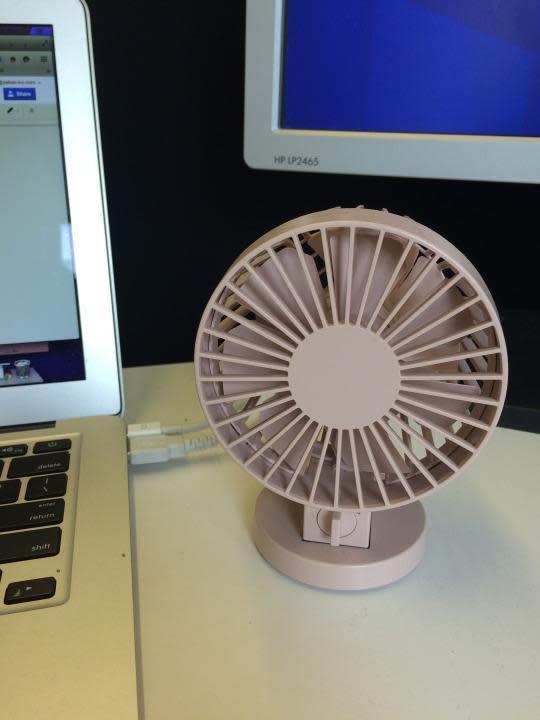
Here is my mini USB fan. I got it from Muji. (Photo: Amanda Chan/Yahoo Health)
The other one is a folding hand fan. The one I currently use was a wedding favor that I procured last year. (On that note, if you’re getting married and need an idea for favors, FANS. I’m tellin’ ya.) It has a permanent spot in my purse, and I use it when I’m on the subway platform, in the subway car, waiting outside a restaurant for a friend — heck, sometimes I even use it when I’m already in the restaurant. In December, the fan cracked in half and in an act of sheer desperation, I used packing tape to cobble it back together.
Oh, so you don’t spend this much time thinking about fans and ways to keep cool?
You must not be a sweaty girl.
Chapter 1: The Struggle
I’ve been a sweater for as long as I can remember. I’m from Phoenix, Ariz., so let’s just say I’ve never not felt overly warm. Plus, I have jet-black hair, which is an excellent absorber of heat!
You’d think things would be better for me now upon moving to New York City, since I no longer live in an actual, literal desert. But you’d be wrong. It is here in NYC that I discovered how I deal with humidity. Hint: Not well. Why is there moisture coming out of every single pore of my body? How is it possible for my entire back to be soaked, even when I have barely moved a muscle? Why does it feel like an entire bottle of water just got dumped over my head and is now dripping down my neck? HUMIDITY!
So on the subway in the winter, even in the middle of a polar vortex, I’m the one wearing a tank top while everyone else is bundled up in coats and sweaters. And in the summer, I have a subway strategy that I employ religiously, outlined for you here:
If the train is approaching, I AM GETTING MY A** ON IT. Waiting another five minutes on the platform without air conditioning is, put simply, not an option. (Unless I want people to think I just took a dip in a super-secret subway station pool that doesn’t provide towels to dry off afterward.)
I always enter the middle of the subway car, at least on the line I take. The ends of the cars don’t have vents, so there’s no air movement. It’s always worth it to be crammed in the middle of the car in order to stand directly under that glorious A/C.
Once in the subway, I always make sure to have at least one hand free to use the aforementioned hand fan to swat any and all air toward my face. And I always keep a rubber band handy to tie my hair into a little bun so my neck isn’t drenched.
For sweaters, the subway struggle is real. (Illustration: Erik Mace for Yahoo Health)
Of course, these actions only go so far — it’s not like they actually prevent sweating. While I don’t think I’m quite at the level where I need medical intervention (thankfully, I don’t have to bring changes of clothes to work or feel embarrassed shaking others’ hands), it is something that I am mildly self-conscious about and do have to plan some aspects of my life around. Which brings us to chapter 2.
Chapter 2: The Rules
Every sweaty girl or guy knows that there are just some life rules you have to abide by when you have sweat glands like ours. They include:
Wear a lot of black clothing. Unless another color is invented that hides sweat as well, then this is my go-to. And no silk — the shirt/dress will be sweat-stained almost immediately, and I don’t have a billion dollars to spend on dry cleaning.
Be choosy with antiperspirant. Unless it’s clinical strength, it’s just a waste of money. (And on that note, antiperspirant ≠ deodorant. Deodorant makes it so you don’t stink. Antiperspirant makes it so you don’t sweat.)
Exercising indoors? Wear shorts. So you know how everyone already sweats a ton when they work out? Sweaters sweat that much, but times a million. That’s why shorts always beat pants. And tank tops only, unless I want a soggy-sleeve situation.
Wash your hair every day. All of those cool beauty articles telling you how great it is to go three days without washing your hair? Ha-ha. Good one.
Have a fan in every room. It doesn’t matter if it’s the winter or not. A fan will always be necessary. I’ve got a high-powered one in my living room that I adore.
Admire hats — but realize that they can never really be for you. Because they make your head really freaking hot.
Chapter 3: The Science
But why is it that some people — like moi — sweat more than others? According to New York City-based dermatologist Neal Schultz, MD, founder of DermTV.com and creator of BeautyRx by Dr. Schultz, it’s the same reason some people are taller than other people.
“Sweating, in part, has a neurologic input and certainly, for some people who sweat more than others, emotional or anxiety issues will trigger it,” Schultz tells me. But there is some biologic variability, where some people “are more sensitive to normal input and they just make more sweat.”
First things first, know that not all sweat is the same. There is something called apocrine sweat, which correlates with sexual activity, arousal, and matters of the brain. However, this is not the same thing as eccrine sweat, which is the sweat we are talking about in this piece and what most people think of when they think of sweat — that clear, salty, watery liquid that comes out from our skin when we’re hot.
Eccrine sweat is part of the body’s thermoregulatory system, meaning it keeps the internal temperature in check. The way it works is simple: When your temperature rises, your sweat glands make more sweat to lower the temperature. When sweat evaporates, it takes heat with it — thereby lowering the body temperature.
Now, for people who sweat more than others, it’s not entirely known whether their sweat glands actually produce more sweat or if they possess a greater number of sweat glands, Schultz says, though he suspects it’s the former and not the latter. “If it was more sweat glands, they’d be sweating all the time, and that’s not the case,” he explains. That’s because everyone is actually always sweating — sweaters and not-so-sweaty people alike — due to a normal bodily function called insensible sweating. It’s just that we can’t always feel this kind of sweating.
“Part of the breathing of the skin involves sweating 24/7. But if the rate of sweating is less than the rate of evaporation, then you get no accumulation, so you don’t know it’s happening,” Schultz says. “That’s the reason why when you’re sitting under an umbrella at the beach for two to three hours, not moving a muscle except for your heart beating, you still need to apply sunscreen because insensible perspiration is leaching your sunscreen off.”
OK, so we’ve established that everyone is sweating a little bit all the time, and some people sweat more than others — but how can you tell when it’s become an actual medical issue, requiring treatment?
The key to knowing if you have hyperhidrosis (the medical term for unpredictable and excessive sweating): It significantly affects your quality of life. Schultz’s patients with hyperhidrosis “can’t get through a meeting without dripping. They need to change their tops five or six times a day because of sweat,” he explains.
Chapter 4: The Solutions
If you’re a sweater who is looking for some relief, the first treatment you should try is a topical antiperspirant, Schultz says. It works by temporarily blocking the sweat gland so sweat can’t get out. Drysol, Certain Dri, and Arrid Extra Dry are some effective options, he says.
With Drysol and Certain Dri, the active ingredient is aluminum chloride, which for some people can cause irritation. So if you’re sensitive to aluminum chloride, Arrid Extra Dry, with the active ingredient aluminum chlorohydrate, is a good alternative, he recommends.
Schultz says that when used in localized areas (like the armpits), antiperspirants are not dangerous in terms of thermoregulation and sweating. However, in order for them to work, he says it’s important that they be applied to dry, clean skin. And if it’s not doing the job when you apply it in the morning, apply it at night as well. That way, “it has time for it to get in [the sweat glands], but more importantly, there’s much less sweat trying to get out at night time that’s fighting the penetration of the antiperspirant,” he explains.
Related: Do You Sweat Too Much?
For people with hyperhidrosis, sometimes topical antiperspirants just don’t cut it — and more drastic measures must be taken beyond a roll-on or spray-on solution:
Botox injections, which temporarily block the signals of nerves responsible for the stimulation of sweating
Medications called anticholinergics, which block the neurotransmitter acetylcholine, the chemical that goes from the nerve to stimulate the muscle and sweat gland
Surgery, where the nerves are cut so that the body no longer receives the signal to sweat
However, each of these has its downside. Botox, for instance, isn’t great on the hands or feet because it weakens the muscles, Schultz says. Anticholinergics can zonk a patient out (they have a sedating effect). And surgery can be dangerous, since it involves the cutting of nerves and can lead to compensatory sweating elsewhere in the body (particularly the chest). If you’re struggling with excess sweating, make sure you talk to your doctor to determine the best treatment option for you.
Chapter 5: The Time I Became a Human Guinea Pig
I’ll try most anything once if it claims to help deal with sweat. To that end, I’ve tested some products out on the market today that are targeted to us sweaters. And on the whole, I was actually pleasantly surprised that they seemed to work to varying degrees. (Of course, just because something does or doesn’t work for me, doesn’t mean it will or won’t work for you.)
Here is what I tried:
Knockout Nighties and Panties
Oh, I didn’t mention that I not only sweat during the day, but also during the night too? While sweating while you sleep is usually totally normal (it’s a way to regulate the body’s internal thermostat), that doesn’t mean it’s not a total pain in the rear. So when we got Knockout nighties and panties in the mail here at Yahoo Health to test out, I snagged them for my Diary of a Sweaty Girl.
Related: What Causes Sleep Sweating?
First, the nighty — which is basically a long T-shirt that covers the bum. It’s 100 percent cotton, which is definitely good for breathability.
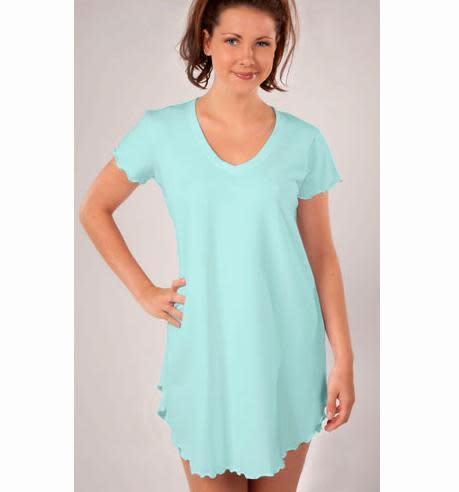
The Knockout nighty is marketed as “the only 100 percent cotton wicking sleepwear on the market.” (Photo: Knockout)
I used this nighty for several nights and found that I didn’t feel stifled or overly warm as I slept because of its thin-enough fabric. The fabric didn’t seem to trap heat. I did, however, still sweat — but at least I felt a lot more comfortable as I drifted off each night.
I also tried the Knockout panties, which have a built-in cotton liner. While I don’t exactly have an excessive sweating problem down there, I figured they could still be an interesting product to try during workouts when everything gets a little extra sweaty. So I took them for a spin during a trip to the gym.
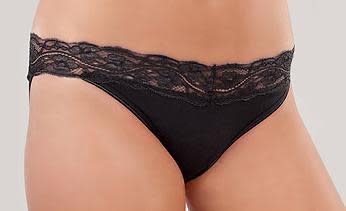
According to the website, the Knockout panties’ “patented cotton liner absorbs – everything!” (Photo: Knockout)
My verdict: They felt like how most of my other cotton underwear feels, though perhaps a little cooler and drier? Maybe? If anything, I mentally felt more secure and comfortable, even if that wasn’t actually the case. (Placebo effect?)
SweatBlock
I’m a faithful Certain Dri user — have been for years — but I’ll take all the help I can get. So when I saw SweatBlock, I thought, ah, let’s see if you work.
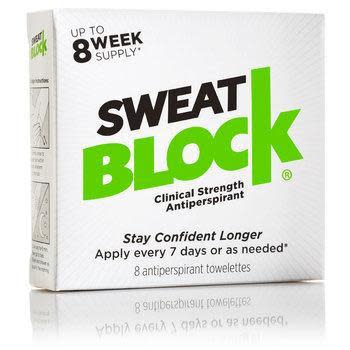
Like a baby wipe … but doused in antiperspirant. (Photo: SweatBlock)
SweatBlock comes in the form of an antiperspirant towelette, which you swipe on your armpits. It claims to be effective for up to seven days and contains 14 percent aluminum chloride. I swiped this puppy on and didn’t expect much. But it actually seemed to work. I didn’t feel damp during my typical sweaty-mess commute, and I noticed that I actually did feel drier when I finally plopped down at my desk after my subway-to-office walk. I can’t say that the no-sweat effects lasted the full seven days (at least for me), but I’d say they lasted at least a good, solid four days.
Belly Bandit “Don’t Sweat It” Bra Liner
I hope this isn’t gross (and oh well if it is), but any sweaty lady knows that the bra is the first victim when you’re getting a little drippy. So that’s why I was willing to give the Belly Bandit bra liner a whirl. According to the product description, the “soft, bamboo material gently absorbs moisture while moving with your body. Any size, any age or any activity … these sweat soakers are the perfect way to stay dry and comfortable around the clock.”
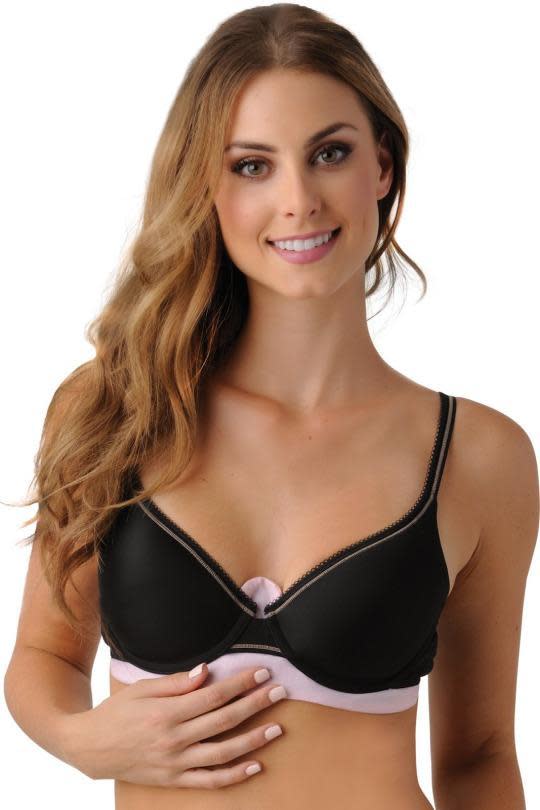
Belly Bandit’s bra liner is made with bamboo material. (Photo: Belly Bandit)
The way this liner works is you tuck it underneath your bra band … and that’s about it. I was skeptical that it would actually stay put (I was anticipating it falling out from under my bra, and me having to explain to my coworkers why there was a weird piece of pink fabric hanging out from under my shirt), so I wore it with a dress that was a bit tighter on top. I took the liner for a spin on a humid, 85-degree June day, where my outdoor activity involved walking to and from the subway and office.
The verdict? To be honest, I completely forgot I had it on — which is probably the entire point! (Since you don’t want to feel like you have a piece of fabric tucked into your bra all day.) I didn’t feel particularly sweaty or not sweaty. If anything, it likely saved my bra from the sweat stains that would have inevitably occurred had I not had it on.
Chapter 6: The Conclusion
If you have a sweater in your life, give ’em a hug. There are a lot of us, and some of us do a better job of hiding it than others. And try not to make fun of us when we pull out our portable fans or grab a tissue to sop up the sweat dripping from our necks. We’re just doin’ what we need to do. And to my fellow sweaters: What works for you? Leave a note in the comments so we can all help each other out. And sweat on!
Read This Next: Don’t Sweat It! Tips to Control and Reduce Sweat
Let’s keep in touch! Follow Yahoo Health on Facebook, Twitter, Instagram, and Pinterest.
Have a personal health story to share? We want to hear it. Tell us at YHTrueStories@yahoo.com.

